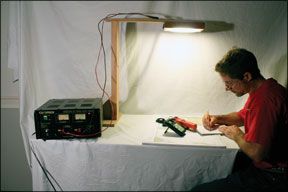When we last dropped in on the realm of interior lighting (Practical Sailor January 2009), we looked at light emitting diode (LED) replacements for incandescent bulbs in a traditional bulkhead-mounted reading light. The test revealed some significant advances in LED technology, and those advances continue today at a lightning pace. Responding to the call for energy efficiency, LED makers are packing more and more luminosity output into smaller and smaller packages.
What We Tested
As our reading light test showed, LED technology has developed to a point where finding LED “bulbs” that can provide enough illumination for reading is no longer an issue. Results from that comparison promptedPractical Sailor to consider whether another key light on our boat-the galley light-could soon go the way of the incandescent reading light. Unlike reading lights, a galley light needs to cast a very wide beam angle to illuminate a large area, something LEDs alone are not very good at. Typically, a diffused incandescent dome light, or a fluorescent light has been tasked with this job. Lenses also play an important role here.
Before diving head first into the LED overhead options for the galley,Practical Sailor felt a quick fluorescent galley light shootout was in order. Though hardly comprehensive, the three-way faceoff involving lights from Alpenglow, Cruising Solutions, and Lunasea offer a cross-section of whats currently available in fluorescent galley lights. To make things interesting, testers included a couple of older LED lights that emerged from our workshop and the cheapest overhead light we could find locally, a 12-volt dome light from West Marine.
Ultimately, the aim of the comparison would be to help determine the criteria for an LED overhead light test as well as help establish a baseline for what to expect from todays fluorescent lights.
Alpenglow 9W Overhead Light
Alpenglow is a familiar name to longtime PS readers. The company, based in Eureka, Mont., has been building a small line of purpose-built marine lights since 1988. Though expensive compared to store-shelf variety lights, Alpenglows lights are a far cut above the average marine light. They have generally done well in pastPractical Sailor tests, andPractical Sailor readers have consistently praised their customer support. Their dimmable LED reading light earned a recommendation in our January 2009 test.
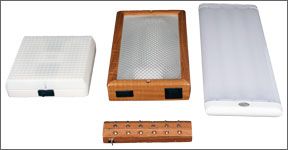
The 9-watt compact fluorescent light (CFL) with electronic ballast is a good example of what can be accomplished when a manufacturer aims squarely at the cruising market. The light features high-power and low-power modes for white CFL light, as well as a high- and low-power modes for a red LED light.
In the high-power white mode, the lens spreads warm light around the cabin as well as provides ample light for working or reading. You can still read a cookbook in the low-power white light mode, though cabin illumination is reduced by about half. The high-power LED mode suits chartwork, the low-power LED mode provides a useful low-draw “night light” that can be left on all night during passage.
Nicely trimmed in wood, the Alpenglow had the most pleasant color temperature of the group. The light lens effectively diffused the light around our test “cabin.” The light flickered briefly while input voltage was adjusted, and there was a 4-percent drop in output when voltage was reduced to 11 volts. Voltages of more than 15 volts fore extended periods can harm the ballast, although this should not be an issue on most boats with conventional battery and charging systems, and is not an issue with the red LED.
Bottom line: The most expensive light in our group, the Alpenglows low output per amp, low bulb price and classic wood trim would appeal to a cruising sailor looking to combine quality, practical galley light with traditional aesthetics.
Lunasea Calypso
Lunasea Lighting, based in Homossassa, Fla., is a subsidiary of Digitron Electronics. The company builds a wide range of cold cathode fluorescent (CCFL) and LED lights for the automotive and marine markets, as well as for medical and industrial purposes. The four-tube CCFL light with a built-in dimmer we tested employs the same technology that Digitron usea for backlighting in laptop computers.
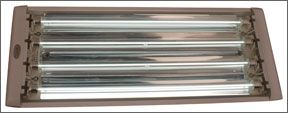
The Calypso (also available with a red tube) stood out for its microprocessor controlled switching, stable output at low voltages, and powerful output. With 636 lux projected on our test counter at high power, the light was brighter than our overhead fluorescent office lighting. This is the light youd want for removing sea urchin spines. The color temperature was all business, cool bright white. Dimming added some warmth, but this is not the light for romancing.
Because the light has no ballast, there is no need for it to warm up to reach maximum output. Also, it didnt flicker or vary its output when voltage was reduced. The switch has a built-in night light that draws less than .002 amps, according to the maker. To dim, you hold the switch down. Double tap to turn it off. A single touch activates 15 second delay before switching off, allowing you to exit the cabin while it is still illuminated. When you turn it on again, it remembers its last setting. Very smart.
Bottom line: This light draws 1.4 amps at full output, but at half-power, its long-life bulbs match the CFLs in terms of energy efficiency. If you like bright working environments, this is the light for you. Wed opt for the red-and white-bulb version.
Leisure Light
Developed in the United Kingdom and widely used in commercial and recreational boats, the Leisure Light is a no-frills square electronically ballasted fluorescent light that efficiently provides the right amount of light for the average galley. This light took the longest to warm up, from 230 lux at the start, to 273, after about 10 minutes. The plastic fixture we tested was bland, but there is a prettier wood-trim version.
According to the distributor, Cruising Solutions, they are seeing a trend away from these lights toward new LED bulbs. Cruising Solutions recently added to its lineup of products a 12-LED bulb from Cree that fits into a conventional dome light.
Bottom line: At $70, this is the least expensive CFL light in our field. Theyve been well tested in field applications, and should provide a long service life. Look for sales markdowns on these lights as LED technology takes hold.
Non-Fluorescents
Our three non-fluorescent samples were an odd assortment: a hand-carved mini-light from the jungles of Fiji, a first generation LED dome light from Doctor LED, and a back-to-basics incandescent dome from West Marine. While the LEDs efficiency was impressive, none of the lights came close to the fluorescents in terms of cabin illumination. We expect to see better performance from some of the more powerful units introduced last year and improved with special lens and refractors, which we will be looking at in our next test.
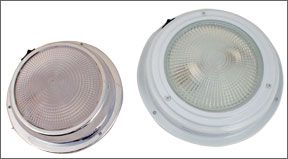
Bebi Fautasi: This light uses an array of 18 bare LEDs to provide white illumination. Like all Bebi lights, the Fautasi is made by villagers on the island of Savu Savu, Fiji, using mostly local materials. Output was modest, but two or more lights could be combined for a brighter galley. This would be a good choice for a small boat with limited battery capacity or the amp-miser who likes to adhere to an eco-friendly ethos.
The Doctor LED: This first generation “Mars” dome light uses a 1-watt US-made high flux LEDs instead of the usual 10-watt halogen or xenon bulb. Maximum output was the lowest of the lights we tested, but the latest version has two Cree LEDs and promises double the light output. We will look at the latest Doctor LED overhead in our LED comparison.
West Marine dome light: One quarter to one half the price of any other light in this test, this 5.5-inch Made in China light is a poster child for cheap illumination.
The light from a single 10-watt halogen bulb was warm and bright, but could not hold a candle against the brighter fluorescent lights.
Conclusion
In the end, two lights stood out, the dimmable Lunasea and the four-lights-in-one Alpenglow. The Lunasea is clearly the light for those who like a bright galley. It is extremely powerful, and the switching technology is impressive. Wed opt for the red-tube version.
The less potent, but warm-temperature Alpenglow offers more versatility at sea. Everything on a boat must serve at least two functions, this one performs four.
Either light would be a very good choice to replace an existing overhead fluorescent.
Galley Lights
| LIGHT | PRICE | TYPE | WARRANTY | BULB COST / LIFE | SIZE H x W x D | LUX* 12V | AMPS @ 12V | COLOR TEMP.** |
|---|---|---|---|---|---|---|---|---|
| ALPENGLOW 9W OVERHEAD | 119 | CFL (white) LED (red) | 3 year | $6 / 2 years | 8.75 x 5.5 x 2 in. | High 249 lx; Low 135 lx; Red high 12 lx; Red low 2 lx | High .8 amps; Low .47 amps; LED .04 amps; LED .01 amps | 2700 K |
| BEBI FAUTASI | 49 | LED | Lifetime | $49 / 50,000 hrs. | 6 x 1.5 x 8 in. | 108 lx | 0.7 amps | 3200 K |
| DR. LED* MARS DOME | 98 | LED | 1 year | $98 / 30,000 hrs. | 5.5 x 2 in. | High 71 lx; Low 40 lx | High .15 amps; Low .07 amps | 3200 K |
| LUNASEA CALYPSO | 90 | CCFL | 3 year | $10 / 30,000 hrs. | 14 x 5.5 x 1.3 in. | High 636 lx; Low 83 lx | High 1.4 amps; Low .20 amps | 4202 K |
| LEISURE LIGHT | 70 | CFL | 1 year | $14 / 15,000 hrs. | 6 x 6 in. | 230 lx | .66 amps | 3500 K |
| WEST MARINE | 20 | 10W Halogen | 1 year | $7 / 1,500 hrs. | 7 x 2 in. | 157 lx | .83 amps | 2900 K |
| *Output as tested at a given spot | **Manufacturer's data |
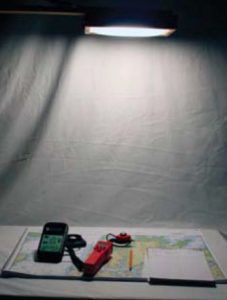
For testing, the lights were mounted one at a time above our test “counter” for measurements. Two calibrated light meters were used to evaluate luminosity. Data was supplemented with independent visual observations. All tests were conducted in a dark room against a white background wall.
• Spot Illumination: Intensity within a 5- degree cone at 25 inches was measured with a Meterman # LM631 digital light meter and a Lutron LX-100. The table data (at left) expresses this light output in lux, the measurement of light at a given spot. The quantity of light cast in all directions is measured in lumens.
• Power consumption: Lights were connected to a regulated 12-volt power source, and power consumption in amps was measured by an Actron CP7677 digital multimeter. Brightness was recorded at three voltage settings: 13 volts, 12 volts, and 11 volts.
• The chart shows factory specs for color temperature in Kelvin (K). A lower Kelvin number indicates a more yellow or soft “warmer” light output. These numbers are consistent with testers’ observations.
• Radio frequency interference: Ballasted fluorescent lights have been known to create radio frequency interference (RFI) that can interrupt on board radio reception. Newer digitally ballasted lights usually do not create significant RFI. We tested for RFI by holding a small batterypowered AM radio operating at various frequencies about 12 inches from the bulbs. None of the bulbs produced noticeable RFI beyond a 3-foot radius.
• Counter illumination: Lux readings were also taken at three locations along the perimeter of a 4-foot diameter semicircle on the same plane as the test counter.
































